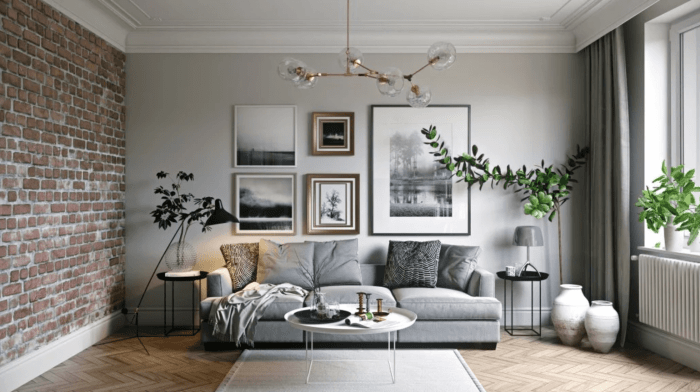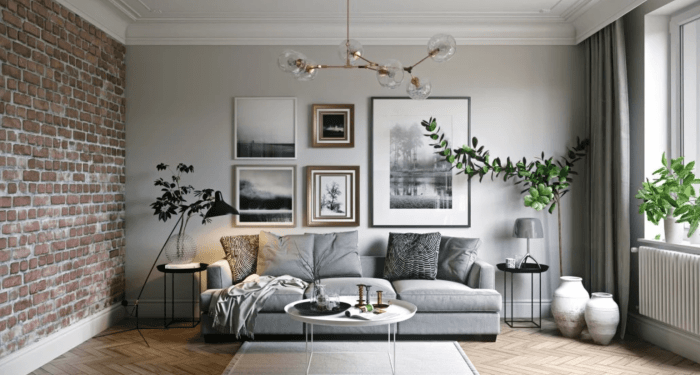Embark on a journey through the world of interiors, where every design choice plays a crucial role in shaping the atmosphere of a space. From the importance of balance and harmony to the influence of lighting and color psychology, interiors hold the power to transform a room into a captivating oasis of style and functionality.
As we delve deeper into the realms of interior design, we uncover the intricate details that contribute to the overall aesthetic appeal and functionality of a space.
Importance of Interiors in Design

Interiors play a crucial role in creating a cohesive design aesthetic within a space. They have the power to tie together various elements of a room, such as furniture, colors, textures, and lighting, to establish a harmonious and visually appealing environment.
Enhancing or Detracting from the Overall Feel
The interiors of a space can either enhance or detract from the overall feel and ambiance of the area. For example, well-thought-out interiors with a balanced color palette, proper lighting, and functional furniture can create a welcoming and comfortable atmosphere.
On the other hand, cluttered or mismatched interiors can make a space feel chaotic and uninviting.
Evoke Specific Emotions or Atmospheres
Different interior styles have the ability to evoke specific emotions or atmospheres within a space. For instance, a minimalist interior design with clean lines and neutral colors can create a sense of calm and serenity. In contrast, a bold and eclectic interior with vibrant hues and mix-matched patterns can evoke feelings of energy and creativity.
Elements of Interior Design
When it comes to creating a well-designed interior space, there are key elements that play a crucial role in achieving a harmonious and visually appealing environment. These elements encompass various aspects such as lighting, color schemes, furniture layout, and accessories.
Lighting
Lighting is essential in interior design as it can greatly affect the mood and functionality of a space. Proper lighting can highlight architectural features, create ambiance, and enhance the overall aesthetic of a room.
Color Schemes
The choice of colors in a room can significantly impact its atmosphere. Different color schemes can evoke different emotions and set the tone for the space. It's important to consider the psychological effects of colors when designing an interior.
Furniture Layout
The arrangement of furniture in a room can make a big difference in how the space is perceived and used. A well-thought-out furniture layout can maximize functionality, flow, and visual appeal in a room.
Accessories
Accessories such as artwork, rugs, and decorative items add personality and character to a space. They can be used to tie together the overall design concept and add interest to the room.
Balance, Harmony, and Contrast
Balance, harmony, and contrast are fundamental principles of interior design. Achieving the right balance between elements, creating a sense of harmony, and incorporating contrasting elements can help create a visually pleasing and well-designed space.
Textures, Patterns, and Materials
Textures, patterns, and materials play a significant role in adding depth and visual interest to a room. They can impact the look and feel of a space, creating a sense of richness and complexity in the design.
Trends in Interior Design
Interior design trends are constantly evolving, reflecting changes in society, technology, and the environment. Let's explore some of the current trends shaping modern interiors.
Minimalist Design
Minimalist design continues to be a popular trend in interior design, characterized by simplicity, clean lines, and a focus on functionality. This style emphasizes the use of neutral colors, sleek furniture, and decluttered spaces to create a sense of calm and order.
Industrial Design
Industrial design draws inspiration from urban lofts and warehouses, featuring raw materials such as exposed brick, metal accents, and distressed wood. This trend embraces a more rugged and unfinished aesthetic, combining elements of the past with modern touches.
Biophilic Design
Biophilic design seeks to connect people with nature by incorporating natural elements such as plants, natural light, and organic materials into interiors. This trend emphasizes the importance of creating spaces that promote health and well-being through a strong connection to the natural world.
Sustainability and Eco-Friendly Practices
- Interior designers are increasingly incorporating sustainable and eco-friendly practices into their projects, such as using recycled materials, energy-efficient lighting, and non-toxic finishes.
- Consumers are also becoming more conscious of the environmental impact of their design choices, leading to a rise in demand for sustainable and eco-friendly products.
- Green building certifications like LEED are becoming more prevalent in the interior design industry, driving the adoption of sustainable practices in both residential and commercial projects.
Smart Technology Integration
- The integration of smart technology into modern interiors is on the rise, with features like smart lighting, thermostats, and security systems becoming increasingly common.
- Home automation systems allow homeowners to control various aspects of their environment remotely, enhancing convenience and efficiency.
- Smart technology not only adds a layer of convenience to interiors but also contributes to energy savings and improved functionality.
Importance of Lighting in Interiors
Lighting plays a crucial role in interior design, as it not only enhances the functionality of a space but also sets the ambiance and mood. Proper lighting can transform a room, making it more inviting, comfortable, and visually appealing.
Types of Lighting Fixtures and Their Impact
- Ambient Lighting: This type of lighting provides overall illumination to a room and sets the general mood.
- Task Lighting: Task lighting is focused on specific areas where activities like reading, cooking, or working take place.
- Accent Lighting: Accent lighting is used to highlight architectural features, artwork, or other points of interest in a room.
- Decorative Lighting: Decorative lighting fixtures add style and visual interest to a space, serving as both functional and decorative elements.
Tips for Effective Use of Lighting
- Layer Lighting: Combine different types of lighting to create depth and dimension in a room.
- Consider the Function: Determine the purpose of each space and choose lighting fixtures accordingly.
- Use Dimmers: Install dimmer switches to adjust the intensity of light and create different moods throughout the day.
- Highlight Focal Points: Use lighting to draw attention to focal points like artwork, sculptures, or architectural details.
Color Psychology in Interiors
Color psychology plays a crucial role in interior design, as different colors can have a significant impact on emotions, productivity, and well-being in a space. Understanding how colors influence our mood and behavior can help create the desired ambiance in a room.
Effects of Different Colors
- Blue: Known for its calming effect, blue is often used in bedrooms and bathrooms to promote relaxation and tranquility.
- Red: A bold and energetic color, red can increase heart rate and create a sense of excitement. It is often used in dining rooms to stimulate appetite.
- Yellow: Associated with happiness and energy, yellow can brighten up a space and lift spirits. It is commonly used in kitchens and living areas.
- Green: Symbolizing nature and harmony, green is a versatile color that promotes balance and calmness. It is ideal for bedrooms and home offices.
- Purple: Often linked to luxury and creativity, purple can add a sense of sophistication to a room. It is popular in bedrooms and living rooms.
Color Schemes for Different Rooms
- Monochromatic: Using varying shades of a single color creates a cohesive and calming look. Ideal for bedrooms and bathrooms.
- Complementary: Pairing colors opposite each other on the color wheel creates a vibrant and dynamic contrast. Suitable for living rooms and dining areas.
- Analogous: Selecting colors next to each other on the color wheel creates a harmonious and soothing palette. Perfect for home offices and reading nooks.
- Triadic: Combining three colors evenly spaced on the color wheel creates a balanced and lively scheme. Great for playrooms and creative spaces.
Spatial Planning and Layout
When it comes to interior design, spatial planning and furniture layout play a crucial role in creating functional and visually appealing spaces. The way furniture is arranged within a room can impact the flow, accessibility, and overall feel of the space.
Importance of Spatial Planning
Spatial planning involves determining how to best utilize the available space in a room to meet the needs and preferences of the occupants. It helps in creating a harmonious balance between aesthetics and functionality.
Maximizing Space in Small Rooms or Open Floor Plans
- Use multifunctional furniture pieces to save space.
- Opt for light and neutral colors to create a sense of openness.
- Utilize vertical space with shelves or wall-mounted storage solutions.
- Keep the layout simple and uncluttered to avoid a cramped feel.
Creating Flow and Functionality
- Consider the traffic flow within the space and ensure there are clear pathways.
- Group furniture to create designated areas for different activities.
- Balance the visual weight of furniture pieces to maintain harmony in the layout.
- Allow for negative space to prevent overcrowding and promote a sense of openness.
Wrap-Up
In conclusion, interiors serve as the heart and soul of any design, weaving together elements of style, functionality, and emotion to create a harmonious living environment. Whether you're aiming for a minimalist approach or a cozy, eclectic vibe, the key lies in understanding the impact of each design choice on the overall feel of a space.
Dive into the world of interiors and unleash your creativity to craft a space that truly reflects your personality and style.
General Inquiries
How does lighting affect the ambiance of a room?
Lighting plays a crucial role in setting the mood of a space, influencing everything from functionality to the overall feel. Different types of lighting fixtures can create various atmospheres, so it's essential to choose the right lighting for each area.
What are some current trends in interior design?
Current trends include minimalist design, industrial aesthetics, and a focus on sustainability. These trends reflect a shift towards simplicity, functionality, and eco-friendly practices in interior design.
How can color choices impact the emotions in a room?
Colors have psychological effects on individuals, with each hue evoking different emotions. Warm tones like red and orange can create a sense of energy, while cool tones like blue and green promote relaxation and calmness.










